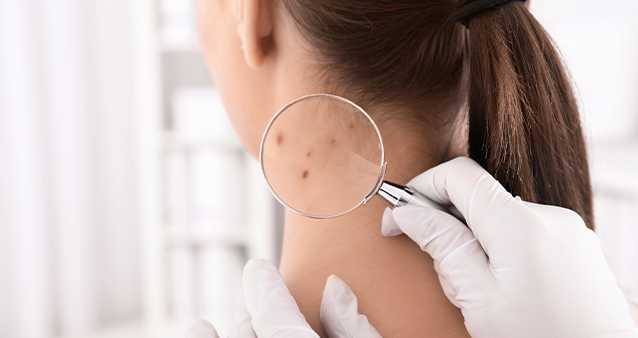Weird Body Stuff (That's Totally Normal)

Before you dash off to the doctor, read this and see if that strange ache, pain or rash is something you really need to worry about.
Do your ears hang low? Do they wobble to and fro? What about your eyes? Did you wake up with yellow inner corners? The good news is that there is most likely a reason for all of that. And the even better news is that these oddities are actually quite common and there's no need for you to raise any alarms just yet.
To figure out what's normal and what's cause for concern, we spoke to two GPs: Somerset West-based Dr Deidre Reed (known by everybody as Dr Rinky) and Dr Karienya Kuga Kasvalu (founder of a mobile practice called Doctors on Location Africa).
Here's what they had to say.
Joints that crunch, squeak, click and crack
Dr Kasvalu and Dr Rinky agree that this is a common complaint and is to be expected. Creaky joints occur when muscles and tendons move over joint spaces and bursae. A bursa is "a fluid-filled sac that encounters friction at the joint," explains Dr Kasvalu.
When to speak to your doctor: "Once it starts causing pain, redness or the inability to move the joint, that's when you need to see your doctor before taking any anti-inflammatory medication," advises Dr Kasvalu.
Heavier than normal vaginal discharge
Dr Kasvalu notes that if there are no other symptoms other than your vaginal discharge being heavier than normal, then there's probably nothing to stress over. If your vaginal discharge has increased, then make sure you're drinking enough water, only use warm water to lightly wash, wearing cotton undies (not tight, restrictive ones) and add some probiotics to your daily diet.
When to speak to your doctor: "Worry if there's burning, itching, fish-like odours, changes in colour, local sores as well as fevers and stomach cramps that aren't related to your period," warns Dr Kasvalu.
All the wonderful colours of your wee
"People worry a lot about the colour of their urine, but strange colours are usually caused by medication, foods like beetroot (known in medical circles as 'beeturia'), and your hydration levels," Dr Rinky assures us. It seems that doctors are more concerned about the clarity of urine rather than colour, and cloudy urine usually denotes a possible infection which would need treatment.
When to speak to your doctor: "Blood in urine, except when women are younger than 50 years old during menses, should always be investigated," states Dr Rinky.
Small cuts on the corners of my lips
"That's called angular cheilitis. This is often caused by a fungal infection or vitamin B2 deficiency, but it's very common in winter to have no cause at all," explains Dr Kasvalu.
Another weird thing your mouth might have is called a geographic tongue. Dr Rinky describes it as funny shapes and patterns on the surface of your tongue. This is actually a harmless inflammatory reaction that's temporary and usually resolves itself on its own.
When to speak to your doctor: If angular cheilitis lasts longer than a week and the small cuts are associated with severe pain, surrounding rash or redness.
An oldie, but a goodie: heartburn
"Common triggers include weight gain, stress, acidic food and drink like vitamin c-filled foods or fruit juice, coffee, alcohol, smoking, corticosteroids and Non-steroidal anti-inflammatory drugs (NSAIDs), and eating too quickly," lists Dr Rinky. The first step is to avoid these common triggers and monitor how you feel, and then reach out to a trusted healthcare provider like a GP or pharmacist if it persists.
When to speak to your doctor: "If it is associated with weight loss, vomiting blood, or not being able to swallow, you should see your doctor," advises Dr Rinky.
Skin raisins?
Those raisins are commonly known as "skin tags" and are nothing to fuss over. They can be easily removed for aesthetic purposes, if you're really bothered by the look of it.
When to speak to your doctor: Dr Kasvalu does highlight that there might be times when it's cause for concern: "If you are overweight these can be a sign of something called 'metabolic disease' which is a cluster of conditions that put you at risk of heart disease, strokes and type 2 diabetes. Otherwise don't sweat it and keep on living your best active, well-balanced life!"
Pain under your heel(s)
This could be from plantar fasciitis, which is the inflammation of fibrous tissue that stretches along the sole of your foot. This pain and inflammation normally occurs on one side only and is often related to those with flat feet or who are carrying around some extra weight. "This should be sorted by good footwear, heel pads and arch supports (or orthotics); by trying rolling exercises with tennis balls or frozen coke bottles; or by avoiding walking on beach sand," says Dr Rinky.
When to speak to your doctor: "If the pain persists, make time to see a physiotherapist, biokineticist or an orthopaedic surgeon for a professional opinion on what to do," adds Dr Rinky.
Bumps or discolouration in nasal corner of eye
"The nodule or discolouration is often yellow, and is called pinguecula or pterygium. It's more common among fair-skinned people and is caused by exposure to sun, wind, dust, or extremely dry conditions," Dr Rinky reveals. Try to avoid triggers and use over-the-counter lubricant drops as well as good eye protection in the form of quality sunglasses. "If inflamed, you may need prescribed cortisone drops," Dr Rinky adds.
When to speak to your doctor: "And if the pterygium is growing on to your iris, you should seek out help from an ophthalmologist to possibly remove it as it can start to impinge on your pupil, and therefore, interrupt your vision."
A mole looks that looks big and scary
Moles, medically known as "naevi", are a normal occurrence most of the time. But remember to always wear sunscreen on your body and face, even when it's cloudy outside - it's one of your best lines of defense! Another one is keeping an eye on the growth and patterns of your moles - a part of "skin mapping" - so you can reach out to your doctor about a potential problem.
When to speak to your doctor: Dr Kasvalu simplifies that with the ABCDE rule. If the mole is Asymmetrical, has an uneven Border, has multiple Colours, is larger than 0.6 cm in Diameter, or if its shape is Evolving or changing in size, shape or colour, be sure to visit your doctor or dermatologist ASAP for a check-up.
Nipple discharge
"Nipple discharge can be normal with stimulation or with drugs like Espiride or Eglonyl, which are commonly used for anxiety and postnatal depression or after breastfeeding," says Dr Rinky. "The best solution would be to stop stimulating or pressing on the breasts as this can cause the discharge to continue due to stimulation of the breast ducts."
When to speak to your doctor: If the nipple discharge is bloody or persistent.
See? Sometimes your body will do weird things, but that doesn't mean you need to dash off to the doctor right away without blowing your medical aid savings. You know your body best, so listen to your gut when you feel like something needs to be checked out... and remember to compare medical aid quotes via our online tool to make sure you and your family are still getting the best deal.
This article is for informational purposes only and should not be construed as financial, legal or medical advice.
Hippo Blog Categories

































